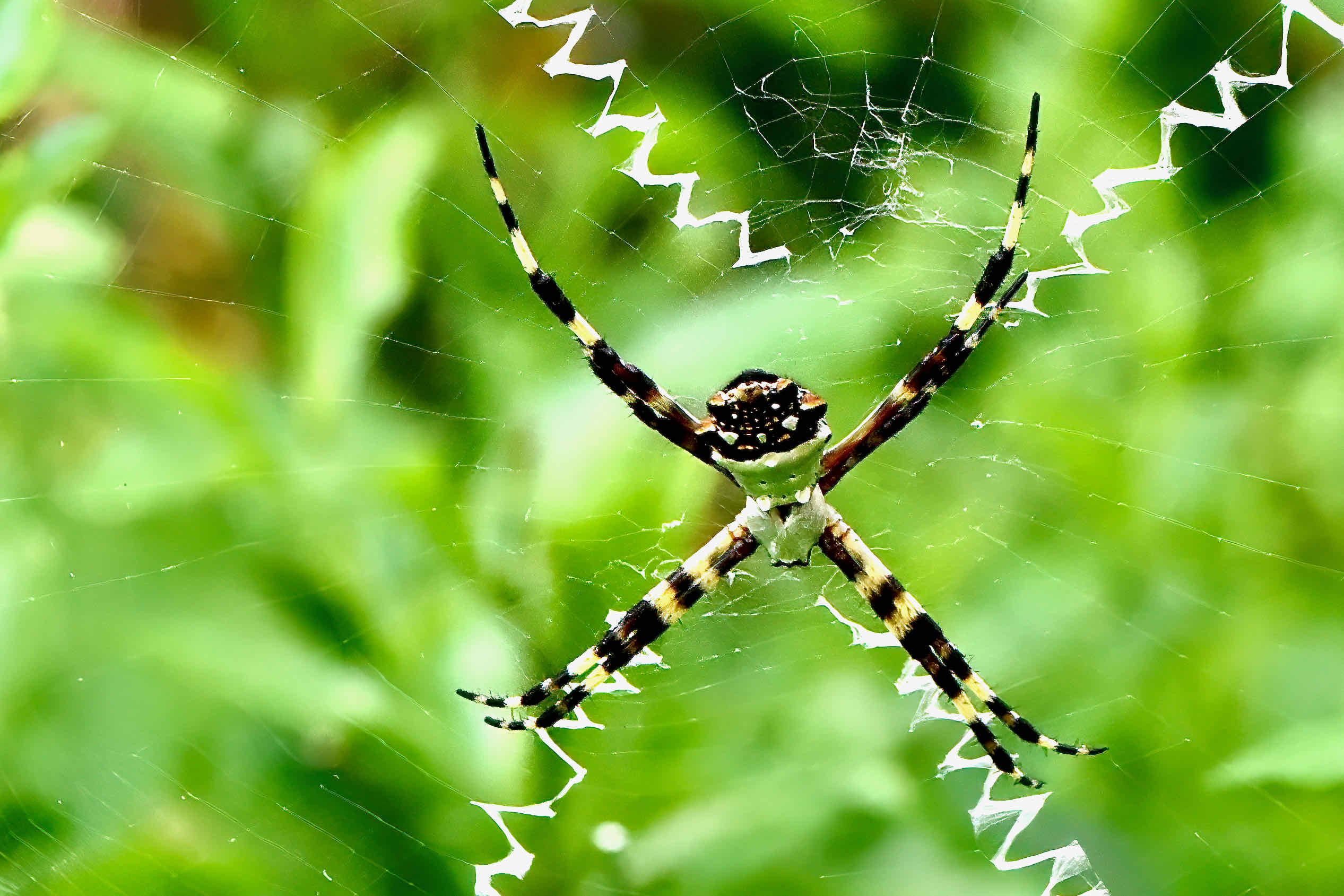
Silver argiope spider, photographed in western Delray Beach, Palm Beach County, in August 2019.
By definition, spiders are supposed to have eight legs. But at first glance, this guy, the silver argiope, Argiope argentata, might appear to have as few as four. Get in a little closer, however, and the full complement becomes apparent.
What you're looking at in all pictures but the one at the bottom left of this page is the female of the species. Like many spiders, it's the female of the species that attain size, as large as 4.75 inches tip of fore legs to the tip of the hind legs. Most of the silver argiopes we've seen are smaller, however. Males are about a third the size of the female and also much duller in color.
As is common with many members of the Argiope genus, it sits in its web head down, its four pairs of legs spread in an X shape (their Australian cousins are known as St. Andrew's Cross spiders). Insects have three body segments — head, thorax and abdomen. Spiders have only two, a combination of the head and thorax, called a cephalothorax and an abdomen. In our guy, the cephalothorax is light gray or silver; the lower portion of the abdomen by contrast is a golden yellow with white spots. The abdomen is almost crystlalline in appearance, reminding us of pyrite, fool's gold.
Silver argiope spiders are fairly common in South Florida and generally harmless. A bite from one for most folk might cause a little discomfort but nothing more, though the very young, the very old or the very sick can be more vulnerable. Silver argiopes are also found in extreme southern California, Arizona and Texas, ranging through Mexico, Central America and much of South America to Argentina.
Silver argiopes tend to hang on the edges of fields, open woods and in gardens, inspiring a couple of other common names. It also tends to move frequently, building a new web every two days, while eating the remants of the old.
Those zig-zag structures in the web are typical of genus Argiope. They're called stabilimenta. Their purpose is unclear but despite the name, it's not believed that stabilimenta actually stabilize the web. Theories include: they warn birds of the web's presence so they can avoid flying into it, although argiope webs tend to be close to the ground. Another theory: the zig-zag lines somehow lure prey. The menu for silver argiopes includes a variety insects — moths, butterflies, grasshoppers, mosquitoes and flies; it will immediately bite butterflies and moths that might escape entanglement in its web, but it will encase other prey in silk first before biting it.
The bite it gives butterflies and moths is called a long bite and is done to kill the victim. The purpose of biting encased prey — what's called a short bite — isn't apparent since the victim is already dead. Some speculate the short bite is a "taste test." Who knows? Maybe silver argiopes are gourmets.
Romance is a deadly business for the males of the species. The guys take up residence in the female's web or build a smaller web of their own nearby and wait to approach a prospective mate until after she's moulted for a final time and likely to be at her least aggressive. He'll pull on "mating strings" within her web, announcing his intentions; if she's interested, she'll move into position to receive him. He'll then climb to the center of the web and jump on her, depositing his sperm inside her in a process lasts a few seconds. The male might croak after mating; if he's lucky he'll mate with the love of his life a second time. If he's still alive afterwards, there's a good chance that he becomes a snack for his lover. One more thing; the male's sexual organs often get stuck in the female during mating and breaks off. This plugs the females' sexual organs, ensuring that no other male can inseminate her, increasing the odds that he's passed on his genetic material to a new generation.
Silver argiopes then encase their eggs in a greenish silk pouch. The photo at the bottom right shows hatchling moving about within the silk pouch.
The silver argiope has a close relative — Argiope blanda. The two are so close, according to the San Diego Natural History Museum, that the only way to tell them apart is by examining their genitalia. Really. Other names for the silver argiope include silver garden spider and silver garden orb weaver. It is a member of Araneidae, the orb weaver family.



